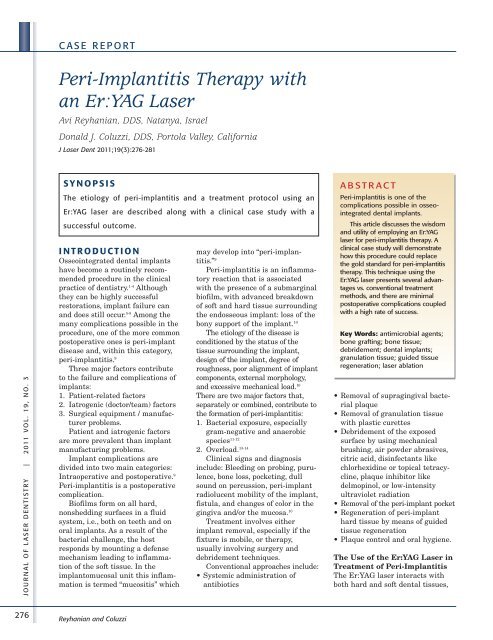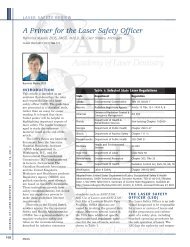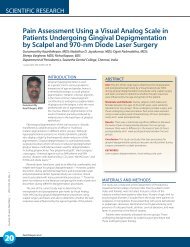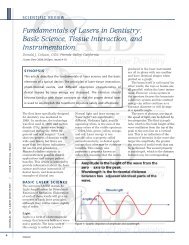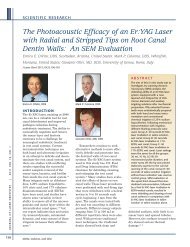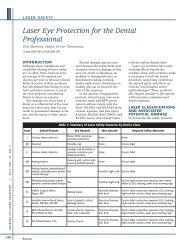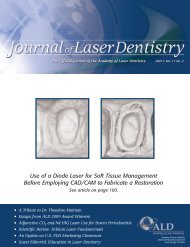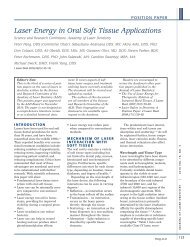You also want an ePaper? Increase the reach of your titles
YUMPU automatically turns print PDFs into web optimized ePapers that Google loves.
J O U R N A L O F L A S E R D E N T I S T R Y | 2 011 V O L . 19 , N O . 3<br />
276<br />
C A S E R E P O R T<br />
Peri-Implantitis Therapy with<br />
an Er:YAG <strong>Laser</strong><br />
Avi Reyhanian, DDS, Natanya, Israel<br />
Donald J. Coluzzi, DDS, Portola Valley, California<br />
J <strong>Laser</strong> Dent 2011;19(3):276-281<br />
S Y N O P S I S<br />
The etiology <strong>of</strong> peri-implantitis and a treatment protocol using an<br />
Er:YAG laser are described along with a clinical case study with a<br />
successful outcome.<br />
I N T R O D U C T I O N<br />
Osseointegrated dental implants<br />
have become a routinely recommended<br />
procedure in the clinical<br />
practice <strong>of</strong> dentistry. 1-4 Although<br />
they can be highly successful<br />
restorations, implant failure can<br />
and does still occur. 5-8 Among the<br />
many complications possible in the<br />
procedure, one <strong>of</strong> the more common<br />
postoperative ones is peri-implant<br />
disease and, within this category,<br />
peri-implantitis. 9<br />
Three major factors contribute<br />
to the failure and complications <strong>of</strong><br />
implants:<br />
1. Patient-related factors<br />
2. Iatrogenic (doctor/team) factors<br />
3. Surgical equipment / manufacturer<br />
problems.<br />
Patient and iatrogenic factors<br />
are more prevalent than implant<br />
manufacturing problems.<br />
Implant complications are<br />
divided into two main categories:<br />
Intraoperative and postoperative. 9<br />
Peri-implantitis is a postoperative<br />
complication.<br />
Bi<strong>of</strong>ilms form on all hard,<br />
nonshedding surfaces in a fluid<br />
system, i.e., both on teeth and on<br />
oral implants. As a result <strong>of</strong> the<br />
bacterial challenge, the host<br />
responds by mounting a defense<br />
mechanism leading to inflammation<br />
<strong>of</strong> the s<strong>of</strong>t tissue. In the<br />
implantomucosal unit this inflammation<br />
is termed “mucositis” which<br />
Reyhanian and Coluzzi<br />
may develop into “peri-implantitis.”<br />
9<br />
Peri-implantitis is an inflammatory<br />
reaction that is associated<br />
with the presence <strong>of</strong> a submarginal<br />
bi<strong>of</strong>ilm, with advanced breakdown<br />
<strong>of</strong> s<strong>of</strong>t and hard tissue surrounding<br />
the endosseous implant: loss <strong>of</strong> the<br />
bony support <strong>of</strong> the implant. 10<br />
The etiology <strong>of</strong> the disease is<br />
conditioned by the status <strong>of</strong> the<br />
tissue surrounding the implant,<br />
design <strong>of</strong> the implant, degree <strong>of</strong><br />
roughness, poor alignment <strong>of</strong> implant<br />
components, external morphology,<br />
and excessive mechanical load. 10<br />
There are two major factors that,<br />
separately or combined, contribute to<br />
the formation <strong>of</strong> peri-implantitis:<br />
1. Bacterial exposure, especially<br />
gram-negative and anaerobic<br />
species 11-12<br />
2. Overload. 13-14<br />
Clinical signs and diagnosis<br />
include: Bleeding on probing, purulence,<br />
bone loss, pocketing, dull<br />
sound on percussion, peri-implant<br />
radiolucent mobility <strong>of</strong> the implant,<br />
fistula, and changes <strong>of</strong> color in the<br />
gingiva and/or the mucosa. 10<br />
Treatment involves either<br />
implant removal, especially if the<br />
fixture is mobile, or therapy,<br />
usually involving surgery and<br />
debridement techniques.<br />
Conventional approaches include:<br />
• Systemic administration <strong>of</strong><br />
antibiotics<br />
A B S T R A C T<br />
Peri-implantitis is one <strong>of</strong> the<br />
complications possible in osseo -<br />
integrated dental implants.<br />
This article discusses the wisdom<br />
and utility <strong>of</strong> employing an Er:YAG<br />
laser for peri-implantitis therapy. A<br />
clinical case study will demonstrate<br />
how this procedure could replace<br />
the gold standard for peri-implantitis<br />
therapy. This technique using the<br />
Er:YAG laser presents several advantages<br />
vs. conventional treatment<br />
methods, and there are minimal<br />
postoperative complications coupled<br />
with a high rate <strong>of</strong> success.<br />
Key Words: antimicrobial agents;<br />
bone grafting; bone tissue;<br />
debridement; dental implants;<br />
granulation tissue; guided tissue<br />
regeneration; laser ablation<br />
• Removal <strong>of</strong> supragingival bacterial<br />
plaque<br />
• Removal <strong>of</strong> granulation tissue<br />
with plastic curettes<br />
• Debridement <strong>of</strong> the exposed<br />
surface by using mechanical<br />
brushing, air powder abrasives,<br />
citric acid, disinfectants like<br />
chlorhexidine or topical tetracycline,<br />
plaque inhibitor like<br />
delmopinol, or low-intensity<br />
ultraviolet radiation<br />
• Removal <strong>of</strong> the peri-implant pocket<br />
• Regeneration <strong>of</strong> peri-implant<br />
hard tissue by means <strong>of</strong> guided<br />
tissue regeneration<br />
• Plaque control and oral hygiene.<br />
The Use <strong>of</strong> the Er:YAG <strong>Laser</strong> in<br />
Treatment <strong>of</strong> Peri-Implantitis<br />
The Er:YAG laser interacts with<br />
both hard and s<strong>of</strong>t dental tissues,


